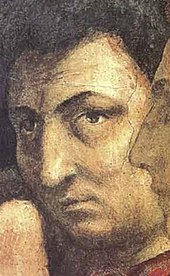Masaccio

Tommaso di Ser Giovanni di Mone Cassai (called Masaccio [ maˈzattʃo ]; * December 21, 1401 in San Giovanni Valdarno in the province of Arezzo ; † 1428 in Rome ) is considered the founder of early Renaissance painting in Florence.
Masaccio lived in Florence from around 1417, where he was apprenticed to Masolino and in 1422 became a member of the painters' guild. From the architect Brunelleschi he took over the mathematically based perspective theory and from the sculptor Donatello the plastic, realistic representation of the human figure.
In his frescoes in particular , he succeeded in creating an exemplary modern mode of expression in terms of perspective, color and light, and the lively representation of the figures. Despite his early death, he exerted a lasting influence on the art of the Renaissance with his formal language .
Life
Masaccio was a pupil of Tommaso di Cristoforo Fini, called Masolino da Panicale , a former colleague of Ghiberti , who worked on the doors of the Baptistery and was also born in San Giovanni Valdarno.
"Masaccio" is a nickname and roughly means "the colossus", which refers to his stature as well as his temperament. He was the true heir to Giotto who defined human form and space as a three-dimensional appearance. Masaccio was inspired by Donatello's sculptures and reliefs and gave his paintings depth by creating the image of clearly physical objects in a fictional space using perspective. Masaccio was the first artist to be able to apply Brunelleschi's developed architectural linear perspective to drawing and painting.
In 1424 Masaccio and Masolino worked on the life of the apostle Peter in the Brancacci chapel of the Florentine church of Santa Maria del Carmine .
The fresco Trinity in Santa Maria Novella (around 1425–1427) in Florence and the picture Anna Selbdritt for Santo Ambrogio in Florence (today in the Uffizi) are considered masterpieces. On the sarcophagus under the fresco of the Trinity there is a grisaille fresco of a dead man. Masaccio succeeded in creating the first scientifically exact representation of a skeleton, half a century before Leonardo da Vinci .
When Masolino was court painter in Budapest from 1425 to 1427, Masaccio continued work in the church of Santa Maria del Carmine. In 1428 Masolino was called to Rome by Pope Martin V , where Masaccio followed him. Both started in the church of San Clemente a large fresco cycle on the life of St. Catherine of Alexandria . Masaccio died there under unknown circumstances at the age of 27, presumably of the plague. It is uncertain whether he was buried in the church of Santa Maria del Carmine. The cycle of frescoes was only completed by Filippino Lippi from 1480 to 1485 .
Important works (partly together with Masolino)
- Panel painting Madonna with Saint Anne (around 1423, Uffizi Gallery, Florence)
- Madonna del Cardinal Casini , (around 1426, Uffizi Gallery, Florence)
- Trinity fresco (around 1425–1427, Church of Santa Maria Novella , Florence)
- Altarpiece for the Church of Santa Maria del Carmine (1426, Pisa, parts of it in London and Naples, among others)
- Cycle of frescoes with scenes from Genesis and from the story of Peter for Santa Maria del Carmine, Brancacci Chapel (1425–1427, later completed by Filippino Lippi , Florence)
- Prayer on the Mount of Olives and Saint Jerome as penitent , around 1424–1425, tempera on poplar wood, 62 × 43.5 cm Lindenau Museum Altenburg
- Martyrdom of St. Petrus , Gemäldegalerie (Berlin) , wood, 21 × 29 cm
- Adoration of the Magi , Gemäldegalerie (Berlin), Predella, wood, 21 × 61 cm
- Four saints , Gemäldegalerie (Berlin), wood, four panels, each 38 × 12.5 cm
- Maternity room of an elegant Florentine woman , Gemäldegalerie (Berlin), round picture, wood, diameter with frame 56 cm
literature
- Roberto Longhi : Masolino and Masaccio. Wagenbach, Berlin 1992. 2011 (p. 73).
- Ugo Procacci : Masaccio. La Capella Brancacci. Sadea Editore, Florence 1965.
- Mario Salmi: Masaccio. The Cappella Brancacci in Florence. Translated into German by Hans Markun. Zurich 1950. - Italian frescoes, volume 1 (= Silvana collection, volume 8).
- Angelo Tartuferi: MASACCIO (Tommaso di ser Giovanni di Mone di Andreuccio). In: Mario Caravale (ed.): Dizionario Biografico degli Italiani (DBI). Volume 71: Marsilli – Massimino da Salerno. Istituto della Enciclopedia Italiana, Rome 2008.
- Giorgio Vasari : The life of Masolino, Masaccio, Gentile da Fabriano and Pisanello . Christina Posselt (Ed.), Klaus Wagenbach Verlag, Berlin 2011. ISBN 978-3-8031-5052-3 .
Picture gallery
The Interest Groschen (fresco), Florence
Web links
- Literature by and about Masaccio in the catalog of the German National Library
- Works by Masaccio at Zeno.org .
- Masaccio in Enciclopedie on line at treccani.it (Italian)
Individual evidence
- ^ London, National Gallery. Retrieved March 8, 2017 .
| personal data | |
|---|---|
| SURNAME | Masaccio |
| ALTERNATIVE NAMES | Cassai, Tommaso; Guidi, Tommaso di Giovanni di Simone |
| BRIEF DESCRIPTION | Italian painter of the early Renaissance |
| DATE OF BIRTH | December 21, 1401 |
| PLACE OF BIRTH | San Giovanni Valdarno |
| DATE OF DEATH | 1428 |
| Place of death | Rome |



